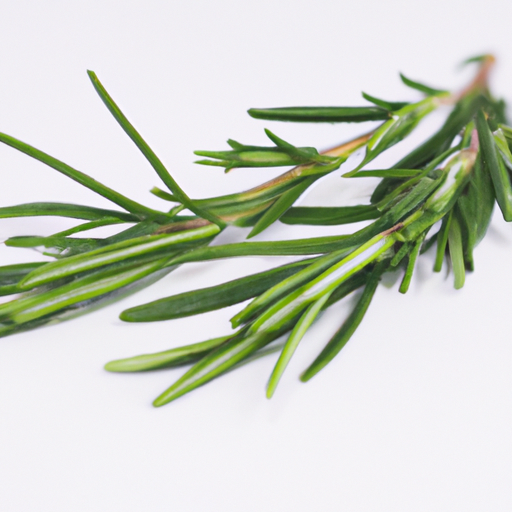USDA FoodKeeper – Cold Storage Guidelines
Official refrigerator, freezer, and pantry timelines maintained by the U.S. Department of Agriculture.
Visit USDA FoodKeeperWith its aromatic charm and culinary versatility, rosemary is a must-have herb that can elevate countless dishes. To keep its vibrant flavor intact, store it in the fridge and use it within seven days for the best taste—though it remains safe for a few days beyond that. So, sprinkle it generously and enjoy its delightful essence, knowing you’re in the safe zone!


Fridge
32-40°F (0-4°C)
Wrap in a damp paper towel and store in an airtight container
7 days
Discoloration, wilting, mold
Infuse in olive oil, make herbal tea, use in DIY beauty products
Thyme, oregano
Sure thing! So, expiration dates and best quality dates for rosemary can be a bit confusing, but I'll break it down for you. Expiration dates are more about safety. Once rosemary reaches its expiration date, it may not be safe to consume due to potential spoilage or loss of freshness. On the other hand, the best quality date refers to the point at which the rosemary may start to lose its flavor and potency, but is still safe to eat. For instance, if you have dried rosemary that has passed its expiration date, it's best to toss it as it might have lost its flavor and could be unsafe to use. However, if it's past the best quality date but still smells good and looks okay, it's probably still safe to use, but the flavor might not be as strong. Personally, I usually go by the smell test. If the rosemary smells off or musty, I'd rather play it safe and get a fresh batch.
To determine if rosemary has gone bad, look for any signs of mold, discoloration, or a slimy texture. Additionally, check for a musty or off smell, which indicates spoilage. Fresh rosemary should have a vibrant green color, a strong aroma, and a firm, not wilted, texture.
Hey Rosemary! I’m always up for a good chat about food safety. Let’s dive into the nitty-gritty of foodborne illnesses, shall we? You know, one of the most common culprits behind foodborne illnesses is improper food handling. We’re talking about things like cross-contamination, undercooking meat, and not washing fruits and veggies. These slip-ups can lead to some not-so-fun symptoms like nausea, vomiting, and diarrhea. So, here’s the scoop: to keep those tummy troubles at bay, try to separate raw meats from ready-to-eat foods in your fridge, use a meat thermometer to ensure proper cooking temperatures, and always wash your hands and kitchen surfaces before and after handling food. I remember one time when I didn’t store my leftovers properly, and let me tell you, I paid the price with a nasty case of food poisoning. Ever since then, I’ve become a stickler for food safety guidelines! Stay safe out there, Rosemary, and remember: when in doubt, throw it out!
Hey there! Rosemary is a great herb to have on hand, but storing it properly is key to keeping it fresh. One cool hack is to wrap fresh rosemary in a slightly damp paper towel, seal it in a plastic bag, and store it in the fridge. This will help maintain its freshness for longer. If you have a bunch of rosemary to store, you can also freeze it. Simply chop up the rosemary leaves, place them in an ice cube tray, cover with olive oil, and freeze. This way, you'll have convenient rosemary cubes ready to use in your cooking. For a more aesthetically pleasing storage solution, consider drying your rosemary by hanging it upside down in a well-ventilated area. Once dried, you can store the rosemary in a cute mason jar or a decorative herb tin. Personally, I love using fresh rosemary in roasted potatoes or chicken dishes. It adds such a delicious flavor! So, make sure to store your rosemary right to always have it on hand for tasty meals.
Oh, let me tell you about rosemary! This fragrant herb is not just great for seasoning dishes—it's steeped in fascinating history and culture! Did you know that in ancient Greece, students would wear rosemary garlands during exams to boost their memory? That's where the saying "rosemary for remembrance" comes from! In the Middle Ages, rosemary was believed to ward off evil spirits and was often used in wedding ceremonies to symbolize fidelity and love. Even today, in some cultures, rosemary is placed under pillows to ward off nightmares and bring peaceful sleep. And here's a fun fact: during Shakespeare's time, rosemary was considered a symbol of friendship and loyalty. It was often included in wedding bouquets and given as a token of affection. So, the next time you sprinkle some rosemary on your roasted potatoes or add it to your marinade, remember the rich history and cultural significance of this wonderful herb!
Rosemary stored at room temperature for 2 days may still be safe to consume, but its quality may have declined. Check for any signs of spoilage such as wilting, discoloration, or a strange odor. To be safe, it's best to refrigerate Rosemary promptly after use to maintain freshness.
Rosemary stored in a plastic bag in the fridge can typically last up to 7 days. Ensure the Rosemary is dry before storing it in the bag to prevent moisture buildup, which can lead to spoilage. If you notice any signs of decay or off smells, it's time to discard the herb.
Cooking Rosemary can impact its shelf life. Fresh Rosemary will retain its flavor longer than cooked Rosemary. If you've cooked with Rosemary, store any leftovers promptly in the fridge to maintain its freshness. Use within 3 days after cooking for the best quality.
Yes, you can store Rosemary next to other herbs in the fridge. However, to prevent cross-contamination of flavors, it's recommended to keep herbs in separate airtight containers or resealable bags. This practice helps maintain the distinct flavors of each herb without them mingling.
Freezing Rosemary can alter its texture slightly. When thawed, frozen Rosemary may become limp and less aromatic compared to fresh Rosemary. It's best to use frozen Rosemary in cooked dishes rather than fresh applications like garnishes to mask any texture changes.
While the quality and freshness of Rosemary can vary between brands, the general shelf life remains around 7 days when stored correctly in the fridge. Factors such as packaging quality and how the herbs are handled during distribution can impact the shelf life of Rosemary from different brands.
When transporting Rosemary for a 4-hour road trip, place the herb in a sealed container or resealable bag to prevent it from wilting or absorbing odors from other foods. Keep the container in a cooler with ice packs to maintain a cool temperature, especially in warmer weather, ensuring the herb stays fresh and safe to use upon arrival.
Rosemary tends to last longer when stored in cooler temperatures, like those in winter. During summer, the herb may wilt or degrade faster due to warmer conditions. To extend the shelf life of Rosemary in summer, consider storing it in the coldest part of the fridge and using it within a few days for optimal freshness.
See Canidigest Digestibility Insights
Dig deeper into how Rosemary behaves in your digestive system.
Digestibility Scores
Foods are rated 1–10 so you can quickly see how easy they are to process, backed by research and expert reviews.
Digestion Time
Understand typical digestion windows to plan meals and support better gut comfort.
Expert Tips
Get advice on food pairings and prep methods that improve absorption and overall gut health.
Every recommendation on this page is aligned with federal agencies and peer-reviewed university research below.
Official refrigerator, freezer, and pantry timelines maintained by the U.S. Department of Agriculture.
Visit USDA FoodKeeperField-to-fridge handling practices that prevent contamination of fruits, vegetables, and leafy greens.
Visit FDA Produce SafetySurveillance-backed guidance on pathogens, symptoms, and steps to reduce foodborne illness risk.
Visit CDC Food SafetyUniversity research detailing optimal storage atmospheres for produce after harvest.
Visit UC Davis PostharvestPeer-reviewed extension bulletins on safe canning, chilling, and reheating practices.
Visit Penn State ExtensionNeed deeper reading? Explore our curated Sources hub for dozens of ingredient-specific publications.
Scan your food directly and get instant safety info using our AI-powered camera feature.
Ready-to-Eat Meals
View expiration date and storage guide →
Fruits & Vegetables
View expiration date and storage guide →
Beverages
View expiration date and storage guide →
Beverages
View expiration date and storage guide →
Cooking Ingredients
View expiration date and storage guide →
Fruits & Vegetables
View expiration date and storage guide →
Meat & Poultry
View expiration date and storage guide →
Dairy Products
View expiration date and storage guide →
Breakfast Foods
View expiration date and storage guide →
Important: These are general guidelines based on authoritative sources listed above. Always use your best judgment and when in doubt, throw it out. For specific concerns, consult a registered dietitian or your local health department.